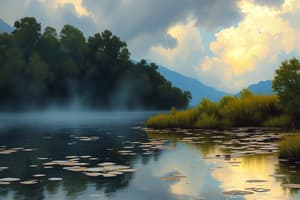Podcast
Questions and Answers
Describe the various storage locations of water in the hydrological cycle.
Describe the various storage locations of water in the hydrological cycle.
The major water storage locations in the hydrological cycle include oceans, surface waters, ice caps and glaciers, soil moisture, water vapor and clouds within the atmosphere, groundwater within aquifers, and organisms.
How does the hydrological cycle move water from one storage to another?
How does the hydrological cycle move water from one storage to another?
Water moves from one storage to another in the hydrological cycle through various flow routes.
What drives the hydrological cycle?
What drives the hydrological cycle?
The hydrological cycle is driven by solar radiation.
Define evapotranspiration and explain its role in the hydrological cycle.
Define evapotranspiration and explain its role in the hydrological cycle.
What is the process by which clouds are formed in the hydrological cycle?
What is the process by which clouds are formed in the hydrological cycle?
How can vegetation affect the hydrological cycle?
How can vegetation affect the hydrological cycle?
What is an example of a human activity that can affect the hydrological cycle?
What is an example of a human activity that can affect the hydrological cycle?
Flashcards are hidden until you start studying
Study Notes
- The hydrological cycle describes the movement of water on Earth.
- Most water on Earth is saline seawater, only 2.5% is fresh water.
- Major water storages include oceans, surface waters, ice caps and glaciers, soil moisture, water vapor and clouds within the atmosphere, groundwater within aquifers, and organisms.
- Water moves from one storage to another through various flow routes.
- Solar radiation drives the hydrological cycle.
- Evapotranspiration is the process of evaporation and transpiration.
- Water vapor cools and condenses onto particles in the air, forming clouds.
- Precipitation falls as rain or snow and can contribute to surface run-off, soil moisture, or groundwater storage.
- Vegetation can slow the movement of water and increase groundwater storage.
- Human activities, such as water abstraction, can affect the hydrological cycle.
Studying That Suits You
Use AI to generate personalized quizzes and flashcards to suit your learning preferences.




